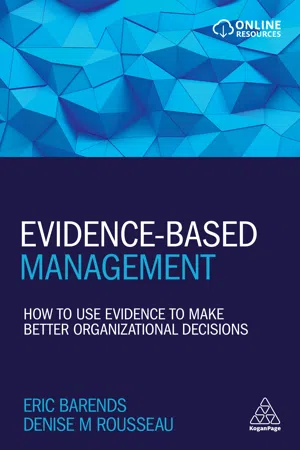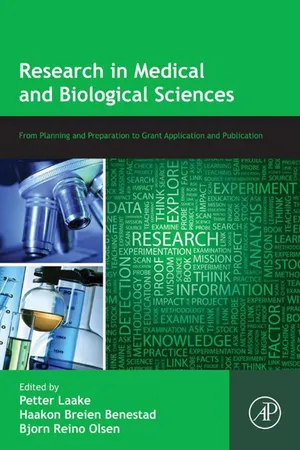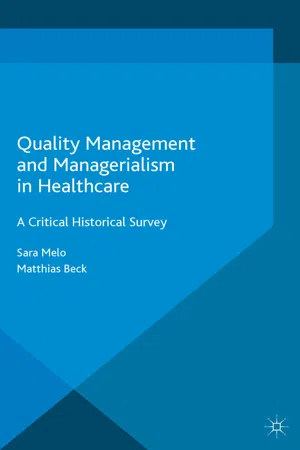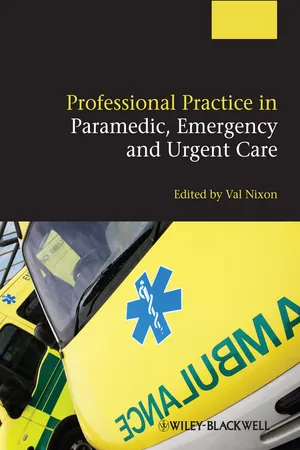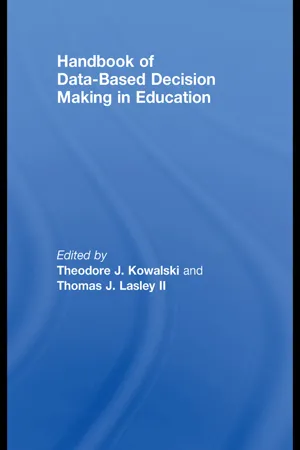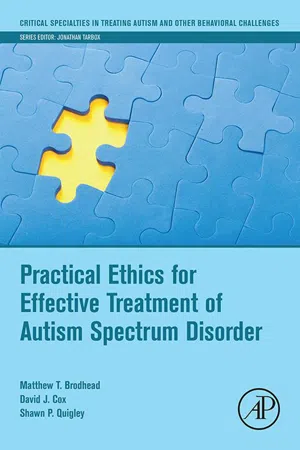Evidence Based Management
Evidence Based Management involves making decisions and taking actions based on the best available evidence from research, data, and experience. It emphasizes the use of empirical evidence to inform business practices and strategies, aiming to improve organizational performance and outcomes. By integrating evidence into decision-making processes, organizations can enhance their effectiveness and achieve better results.
8 Key excerpts on "Evidence Based Management"
- eBook - ePub
Professional HR
Evidence- Based People Management and Development
- Paul Kearns(Author)
- 2013(Publication Date)
- Routledge(Publisher)
...This necessitates a seismic shift from conventional management paradigms to the paradigm of EBM. However, we need to offer much more clarity and definition to what is currently a rather broad and indistinct concept. It might help readers to view EBM as a three-legged stool on which managers should sit and feel secure. The three legs comprise: • Relying on evidence rather than intuition. • Making evidence their first, rather than their last, resort in decision-making. • Seeking real evidence of what works best in the problematic area of people management, not correlations. So where does academia fit into this brave new world of EBM? Would a fourth leg add any greater stability? Academic research and the quality of management evidence Probably the most comprehensive definition of EBM within the academic community is provided in a paper entitled ‘Evidence-Based Management: Concept Cleanup Time?’ by Rob B. Briner, David Denyer, and Denise M. Rousseau (Academy of Management, Perspectives, November, 2009): EBM is about making decisions through the conscientious, explicit, and judicious use of four sources of information: practitioner expertise and judgment, evidence from the local context, a critical evaluation of the best available research evidence, and the perspectives of those people who might be affected by the decision. Defining EBM well is a good start but it does not tell us how to do it. Before we move onto the practicalities we need to remind ourselves once more of the gulf between theory and practice...
- eBook - ePub
Evidence-Based Management
How to Use Evidence to Make Better Organizational Decisions
- Eric Barends, Denise M. Rousseau(Authors)
- 2018(Publication Date)
- Kogan Page(Publisher)
...Whether we work in a bank, hospital, large consulting firm or small startup, as practitioners affecting the lives of so many, we have a moral obligation to use the best available evidence when making a decision. We can do this by learning how to distinguish science from folklore, data from assertions, and evidence from beliefs, anecdotes or personal opinions. 1.1 What is evidence-based management? The basic idea of evidence-based management is that good-quality decisions require both critical thinking and use of the best available evidence. Of course, all practitioners use some kind of evidence in their decisions. But few pay attention to the quality of the evidence. The result is decisions that rely on unfounded beliefs, fads and fashions, and the unsupported though popular ideas of management gurus. The bottom line is bad decisions, poor outcomes and little understanding of why things go wrong. Evidence-based management seeks to improve the way decisions are made. It is an approach to decision-making and day-to-day work practice that helps practitioners to critically evaluate the extent to which they can trust the evidence they have at hand...
- eBook - ePub
Research in Medical and Biological Sciences
From Planning and Preparation to Grant Application and Publication
- Petter Laake, Haakon Breien Benestad, Bjorn R. Olsen(Authors)
- 2015(Publication Date)
- Academic Press(Publisher)
...A widely quoted definition of EBM is given in Box 12.1. Box 12.1 Definition of EBM Evidence based medicine is the conscientious, explicit, and judicious use of current best evidence in making decisions about the care of individual patients. The practice of evidence based medicine means integrating individual clinical expertise with the best available external clinical evidence from systematic research (Sackett et al. 1) EBM marks a “democratization of medical decision-making” and a shift from “authoritarian medicine” to “authoritative medicine.” 2 Expert opinion, which once governed medical decision-making, now carries less weight than scientific evidence. Nowadays, every medical doctor is expected to be up to date on the latest research results, and thus able to form medical decisions based on the best available evidence. This was brought about by a change not only in the social and cultural environment in which clinical decisions are made, but also in the standards for collecting evidence and the tools available to analyze it. The roots of EBM can be traced back to eighteenth-century France and the publication of the first volume of the Encyclopédie. 3 Although this was not the first encyclopedia to be published, it was fundamentally different from previous endeavors because it combined theory and practice. The Encyclopédie contained articles on the arts and sciences, as well as on trades and crafts. It embraced the scientific method, replacing tradition, authority, and superstition with rational explanations and first-hand observations of the world. The Encyclopédie was an effort to systematically assemble all human knowledge—and to change the world. During the last century, the standards for collecting evidence have evolved from single case reports and cohort and case-control studies to randomized controlled trials (RCTs), which are now considered the gold standard for evaluating the efficacy of interventions...
- eBook - ePub
Quality Management and Managerialism in Healthcare
A Critical Historical Survey
- Matthias Beck, Sara Melo(Authors)
- 2014(Publication Date)
- Palgrave Macmillan(Publisher)
...5 Evidence-Based Medicine This chapter explores the origins and the development of evidence-based medicine (EBM), with a focus on the relationship between EBM and healthcare managerialism. Although the origins and key features of EBM have been widely discussed in the clinical and healthcare literature, there is some variation with regard to authors’ views about when EBM was created and what its key characteristics are. While most scholars would consider EBM a relatively recent development which started in the early to mid-1990s, others would locate the origins of the approach to earlier periods. Likewise, while most definitions of EBM would emphasise its focus on clinical practice based on a systematic analysis (and/or meta-analysis) of published research, others would emphasise specific methodologies such as randomised control trials (RCTs) as a means of underpinning medical decisions and practice within EBM. This chapter commences by discussing alternative definitions of EBM. Next it explores some of the tensions between experimental medicine and discovery versus the duty of doctors towards patients, which the literature of the immediate post-war decades identified. The third section examines some of the main critiques of modern EBM as it had been established by the mid- to late 1990s, together with efforts to expand EBM to evidenced-based healthcare and healthcare management. In this context, particular emphasis is placed on the power of the medical profession to resist change and the potential impact of EBM on the hierarchical structure of the medical profession. The fourth part of the chapter examines some of the more recent literature on conflicts of interest and the potentially problematic impact of commercially funded research on the evidence-base of EBM...
- Valerie Nixon, Valerie Nixon(Authors)
- 2013(Publication Date)
- Wiley-Blackwell(Publisher)
...Robertson-Malt (2010) also presents a summary of a Cochrane systematic review of advanced trauma life support for hospital staff. Alongside Cochrane reviews, the development of evidence based medicine (EBM) has also been rapid over the past 10 years and has been led by Professor David Sackett. In the 1990s, other healthcare professions, notably nursing began to embrace the principles of evidence based care and the term evidence based practice (EBP) emerged (Barker, 2010). The Joanna Briggs Institute (JBI, 2011), established in 1996, was another important collaborative organisation and source of evidence for healthcare and had its origins in nursing. Presently, the membership has evolved and includes medical and allied health researchers, clinicians, academics and quality managers. The JBI collaborates internationally with over 70 organisations to provide reliable evidence to inform clinical decision making at the point of care. More information about the background to EBP can be found at the Cochrane and JBI websites (see Box 4.1). The JBI offer guidance on three main aspects of EBP which are 1. Accessing reliable evidence 2. Evaluating that evidence 3. Implementing it in practice Box 4.1 Background to EBP For more information about the origins of EBP, see the websites of the Cochrane Collaboration and the JBI at http://www.cochrane.org/ http://www.joannabriggs.edu.au/Home 1 These stages will be discussed later in the chapter. Some of their resources are freely available to individuals, for example, best practice information sheets, but a number of resources are restricted to JBI members. What is evidence based practice? The most widely cited definition in the literature when considering EBP is essentially a definition of EBM which is ‘The conscientious, explicit and judicious use of current best evidence in making decisions about the care of individual patients...
- Morley D. Glicken(Author)
- 2009(Publication Date)
- Academic Press(Publisher)
...1). Gambrill (1999) believes that EBP “requires an atmosphere in which critical appraisal of practice-related claims flourishes, and clients are involved as informed participants” (Gambrill, 1999, p. 345). In describing the importance of evidence-based practice, The User's Guide to Evidence-Based Practice (1992, p. 2420), findings from a workgroup of The American Medical Association writes: A new paradigm for medical practice is emerging. Evidence-based medicine de-emphasizes intuition, unsystematic clinical experience, and pathophysiologic rationale as sufficient grounds for clinical decision-making, and stresses the examination of evidence from clinical research. Evidence-based medicine requires new skills of the physician, including efficient literature-searching, and the application of formal rules of evidence in evaluating the clinical literature. Timmermans and Angell (2001) indicate that evidence-based clinical judgment has five important features: 1. It is composed of both research evidence and clinical experience. 2. There is skill involved in reading the literature that requires an ability to synthesize the information and make judgments about the quality of the evidence available. 3. The way in which information is used is a function of the practitioner's level of authority in an organization and his or her level of confidence in the effectiveness of the applied information. 4. Part of the use of EBP is the ability to independently evaluate the information used and to test its validity in the context of one's own practice. 5. Evidence-based clinical judgments are grounded in the western notions of professional conduct and professional roles, and are ultimately guided by a common value system. Gambrill (1999) points out that one of the most important aspects of EBP is the sharing of information with clients and the cooperative relationship that ensues...
- Theodore Kowalski, Thomas J. Lasley(Authors)
- 2010(Publication Date)
- Routledge(Publisher)
...Introduction Contextualizing Evidence-Based Decision Making The use of evidence to make decisions is not new to educators in particular or to other practicing professionals (lawyers, doctors, engineers) in general. For the past century, and especially as professional fields have expanded and matured, evidence has been considered a cornerstone of effective professional practice. Patients expect their doctors to use evidence when making diagnoses and offering prescriptions, and, increasingly, parents want teachers who use instructional practices to utilize interventions that are grounded on evidence. The often heated debate connected to scientifically based practice is not really about whether evidence should be used in decision making and by professionals, but rather how evidence (data) is collected, analyzed, and then subsequently used to guide practice. As even the most naive professional practitioner knows, it makes a difference how data are collected and who is collecting them. Once collected, it makes a difference how they are analyzed and evaluated (the assumptions made and statistical tests chosen). Finally, once all the data go from a raw to refined form it matters how policy makers and practitioners use what is “known” to decide what should be done in terms of professional “best practices.” Unfortunately, it is all too common for the biases of practitioners to determine which studies to use as they make decisions about what constitutes effective classroom practice. The reality of most phenomena suggests that there is sufficient complexity to limit transferability of findings from one context to another without at least some qualifications or adjustments and that transferability becomes even more complicated in highly politicized educational environments. Researchers tend to rely on a limited number of observations and that fact has import for generalizing to broader populations or multiple settings (Briggs, 2008)...
- Matthew T. Brodhead, David J. Cox, Shawn P Quigley(Authors)
- 2018(Publication Date)
- Academic Press(Publisher)
...As we will discuss in a bit, client values and professional expertise are also important to EBP. Despite the limitations of this definition, it remains helpful because it highlights that an important component of EBP is how one uses evidence. Strauss, Glasziou, Richardson, and Haynes (2011) provide a more complete definition of EBP. They note that evidence-based medicine “requires the integration of the best research evidence with our clinical expertise and our patient’s 1 unique values and circumstances.” This definition emphasizes three components of evidence-based medicine: research evidence, professional expertise, and client characteristics. Strauss and colleagues emphasize that EBP is a process. This process involves not only evaluating research evidence, but integrating this evidence with professional expertise, client characteristics, and input from various stakeholders (e.g., caregivers). It is again important to emphasize the process-orientated nature of EBP. It is unlikely a published research study exists that describes the specific problem you face and the client you are facing it with. You will necessarily have to use your past clinical experiences and input from those around you to make ongoing decisions for each unique client. The definition from Strauss and colleagues highlights that EBP is not a one-time decision (e.g., I chose to use functional communication training, or not). Rather, EBP is a continuous process of finding available published research evidence, assessing collected data from the treatment program, and obtaining and assessing contextual information unique to your client (e.g., information from caregivers and staff). To summarize, Strauss et al. promote three components of EBP: (1) research evidence, (2) clinical expertise, and (3) client considerations. All three are utilized to make a clinical decision...

